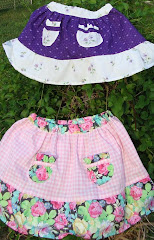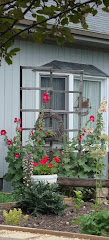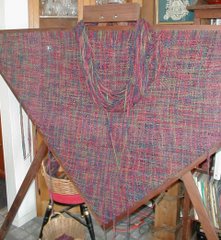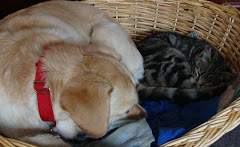I love Charles Dickens' A Christmas Carol. As a child, I only knew it as the written story. Then somewhere along the line, probably on late night tv, I saw the 1938 film with Reginald Owen as Ebenezer Scrooge. Of course, I've since seen a lot of newer film versions, too, including a modern adaptation, Scrooged, with Bill Murray. And, I remember at least two animated versions, one that must be a Walt Disney interpretation starring one of Donald Duck's relatives and another with Mr. Magoo as Scrooge. I admit it -- if there's an adaptation of Carol, I'm likely at least to give it a chance. (There's even a free audiobook version available through LibriVox on archive.org.) But it has to be pretty darn good (and few are) to merit a second viewing because Dickens' words are wonderful all on their own.
For 11 years I've been planning to see A Christmas Carol at Blackfriars Playhouse. It's Dickens' work adapted for the stage, it's nearby and it's always performed by talented actors -- this year ASC's Almost Blasphemy Tour troupe. Every year, I remember to check out the performance schedule months in advance and even go so far as to write in a few "good dates" on my calendar. Then other things come up. Things that, like this play, are only happening during the Christmas season. And another year goes by.
But early last week a friend forwarded a note about a full dress rehearsal scheduled for Sunday evening and open to the public. It wasn't on my calendar. And we didn't have anything else on the calendar for that night, either. So we finally made it to Blackfriars to see Carol. And, boy, am I glad we did. It was great!! Now I just need to put it on the calendar for next year because we want to go back and watch it all over again...
Tuesday, December 6, 2011
Saturday, December 3, 2011
It's started.
There are a lot of things I should be doing. But earlier this week I spent some time crafting -- working on a Christmas tree-themed gift for a swap on Chickens in the Road.
Once again my camera's failing me on color translation but, trust me, I think I'm channeling Dr. Seuss this year. The green in the green-and-red print fabric reminds me of the Osage-orange globes my mom gave me this fall. (Osage orange trees are rare around here so naturally I want one...)
I went searching for handmade gift ideas and quickly found the appliqued tea towel pattern. From there it was easy to decide on the knitted dishcloth I found through Ravelry and then, when I had a few scraps of the printed fabrics leftover, I found the patchwork ornaments through a fun November challenge titled "No Ugly Ornaments". I think I'm going to try #19, the origami dress ornaments next.
Today it's back to regular chores and I need to put up some more taco soup as DH and DS finished the last jar in November and are demanding a refill. But 'tis the season and all that, so I'll be back with another project toshow off share shortly.

Once again my camera's failing me on color translation but, trust me, I think I'm channeling Dr. Seuss this year. The green in the green-and-red print fabric reminds me of the Osage-orange globes my mom gave me this fall. (Osage orange trees are rare around here so naturally I want one...)
I went searching for handmade gift ideas and quickly found the appliqued tea towel pattern. From there it was easy to decide on the knitted dishcloth I found through Ravelry and then, when I had a few scraps of the printed fabrics leftover, I found the patchwork ornaments through a fun November challenge titled "No Ugly Ornaments". I think I'm going to try #19, the origami dress ornaments next.
Today it's back to regular chores and I need to put up some more taco soup as DH and DS finished the last jar in November and are demanding a refill. But 'tis the season and all that, so I'll be back with another project to
Saturday, November 26, 2011
Tuesday, October 11, 2011
Can't forget the lard
This past weekend, a beautiful one by the way, we enjoyed an afternoon with homeschool friends at Polyface Farm. As always the day included a hayride and farm tour followed by a potluck picnic with delicious burgers made from salad bar beef and pigaerator pork. DH came home reinvigorated and ready to implement a few more ideas here at home and I came home with 20 pounds of creamy white pork fat for rendering.
This stuff is gorgeous. Yeah, it's fat and feels greasy but once I put it in the roaster oven, melt it for several hours over low heat and strain it into jars for storage, it's like buttah, I tell you. (Said with a plummy accent...) And, yes, I do this outside -- the roaster oven sets on a small table under the eaves on the back deck. At night I use a couple of bungee cords criss-crossed over the lid to be sure no small nocturnal animal gets into it as it slow cooks. If we had large nocturnal animals, I'd bring it into the garage or shed overnight but other than two coyotes last spring we don't seem to have that issue.
The rendering doesn't make a big mess and the smell isn't bad -- it's just a very rich roasting-meat smell. Makes me hungry, in fact, but also hangs around inside after the rendering's done. So outside is more practical though the wafting scent did raise the expectations of at least one visitor today who was disappointed to learn it was only lard rendering and not the beginning of a pig roast that he could smell.
Once the pork fat's melted, I strain the hot liquid lard through a couple layers of cheesecloth and pour it into canning jars. Put on lids and rings and the lard's ready to use. I store it along with our other canned goods as it will keep on the shelf for a good while. When I open a jar to use, I store the opened jar in the refrigerator. Cold lard makes the best pie crust...
Here's a link to stovetop directions for rendering lard. The basic idea is the same as how I do it except I use an electric roaster oven (set on 200-225ºF.) and don't add any water. If I was only rendering a pound or two, I'd probably go back to doing it on the stovetop or try out one of my crockpots so I could still set it outside.
This stuff is gorgeous. Yeah, it's fat and feels greasy but once I put it in the roaster oven, melt it for several hours over low heat and strain it into jars for storage, it's like buttah, I tell you. (Said with a plummy accent...) And, yes, I do this outside -- the roaster oven sets on a small table under the eaves on the back deck. At night I use a couple of bungee cords criss-crossed over the lid to be sure no small nocturnal animal gets into it as it slow cooks. If we had large nocturnal animals, I'd bring it into the garage or shed overnight but other than two coyotes last spring we don't seem to have that issue.
The rendering doesn't make a big mess and the smell isn't bad -- it's just a very rich roasting-meat smell. Makes me hungry, in fact, but also hangs around inside after the rendering's done. So outside is more practical though the wafting scent did raise the expectations of at least one visitor today who was disappointed to learn it was only lard rendering and not the beginning of a pig roast that he could smell.
Once the pork fat's melted, I strain the hot liquid lard through a couple layers of cheesecloth and pour it into canning jars. Put on lids and rings and the lard's ready to use. I store it along with our other canned goods as it will keep on the shelf for a good while. When I open a jar to use, I store the opened jar in the refrigerator. Cold lard makes the best pie crust...
Here's a link to stovetop directions for rendering lard. The basic idea is the same as how I do it except I use an electric roaster oven (set on 200-225ºF.) and don't add any water. If I was only rendering a pound or two, I'd probably go back to doing it on the stovetop or try out one of my crockpots so I could still set it outside.
Labels:
canning and preserving,
cookery,
field trips,
homeschooling
Tuesday, September 6, 2011
One potato, two potato, three potato, four...
Bushels of potatoes. Mostly Kennebecs, some Yukon Golds and some Red Pontiacs. All neatly sorted and stacked in (thrifted) bread racks, ready for cool, dark and humid winter storage.
That just leaves the culls. A few were culled because they were small. Past experience says that if we store the smallest potatoes, there'll be nothing left when/if they sprout. (Mid-winter we sort through the stored potatoes, breaking off any sprouts and removing rotten ones. Helps keep them through till spring -- or till we eat them all, whichever comes first.)
This was a good year for potatoes so we have only a small dishpan of itty bitty potatoes to deal with. Those won't last two weeks as I'll scrub a potful at a time, boil in their jackets and put them in the refrigerator for use in a baked dish like Doris' Golden Potatoes or make our favorite late morning breakfast -- home fries (cold boiled potatoes, sliced and fried) paired with garden tomatoes, cucumbers and onions in vinegar, plus farm fresh scrambled eggs with just-picked chives. Yum!
The other culls are potatoes injured while digging or showing damage from wire worms or other pests. A few more of those but still not a bad year.
Some will be used over the next few weeks in the usual manner -- mashed, scalloped, roasted or perhaps as oven fries. But today I'm filling the Excalibur with 10+ pounds of grated potatoes so we'll have dehydrated hash browns ready to prepare when needed.
Peeling, shredding and blanching that many potatoes is a tedious job but it's pouring rain outside and the heat from the stove burner and the dehydrator are welcome. DS's helping by running the Salad Shooter and even set up one of Susan Wise Bauer's Story of the World audiobooks for us to listen to as we work. Wish Alex Bellos' Here's Looking at Euclid
audiobooks for us to listen to as we work. Wish Alex Bellos' Here's Looking at Euclid was available as an audiobook, too, since we're using that as a math read-aloud this month but Jim Weiss' narration of Bauer's works are surprisingly soothing on this rainy day.
was available as an audiobook, too, since we're using that as a math read-aloud this month but Jim Weiss' narration of Bauer's works are surprisingly soothing on this rainy day.
 The difference between the white-fleshed Kennebec and Pontiac Red potatoes as compared to the buttery yellow Yukon Gold potatoes makes for some pretty hash browns when laid out on the dehydrator trays but once they're dried the difference will fade to almost nothing. When I'm ready to use, I'll pour boiling water over top, let them rehydrate for 20 minutes or so then prepare according to whatever recipe I'm following. If I'm following a recipe -- these are really good simply tossed on a hot greased griddle and quickly grilled. Maybe with a few onions added...
The difference between the white-fleshed Kennebec and Pontiac Red potatoes as compared to the buttery yellow Yukon Gold potatoes makes for some pretty hash browns when laid out on the dehydrator trays but once they're dried the difference will fade to almost nothing. When I'm ready to use, I'll pour boiling water over top, let them rehydrate for 20 minutes or so then prepare according to whatever recipe I'm following. If I'm following a recipe -- these are really good simply tossed on a hot greased griddle and quickly grilled. Maybe with a few onions added...
Doris' Golden Potatoes
2 cups sharp cheddar cheese, shredded
1/4 cup plus 2 tablespoons butter, divided
2 cups sour cream (*see note)
1/2 cup onion, chopped
1 teaspoon salt
1/4 teaspoon pepper
6 large potatoes, cooked -- approx. 6 cups diced
Cut cooked potatoes into a medium dice.
Combine cheese and 1/4 cup butter in medium saucepan; stir over low heat until cheese is melted. Remove from heat and stir in sour cream, onion, salt and pepper. Add potatoes, mixing gently.
Pour into a greased 2-quart casserole; dot with remaining butter. Bake at 350°F. for 30 minutes.
*Note:
I like to sub lightly drained kefir for the sour cream and when I'm short on cheddar, I use almost any hard cheese or blend of cheeses including Monterey jack, colby, or Swiss that's on hand. And leftover ham, diced and tossed with potatoes, and toasted breadcrumbs sprinkled on top before baking make nice additions.
That just leaves the culls. A few were culled because they were small. Past experience says that if we store the smallest potatoes, there'll be nothing left when/if they sprout. (Mid-winter we sort through the stored potatoes, breaking off any sprouts and removing rotten ones. Helps keep them through till spring -- or till we eat them all, whichever comes first.)
This was a good year for potatoes so we have only a small dishpan of itty bitty potatoes to deal with. Those won't last two weeks as I'll scrub a potful at a time, boil in their jackets and put them in the refrigerator for use in a baked dish like Doris' Golden Potatoes or make our favorite late morning breakfast -- home fries (cold boiled potatoes, sliced and fried) paired with garden tomatoes, cucumbers and onions in vinegar, plus farm fresh scrambled eggs with just-picked chives. Yum!
The other culls are potatoes injured while digging or showing damage from wire worms or other pests. A few more of those but still not a bad year.
Some will be used over the next few weeks in the usual manner -- mashed, scalloped, roasted or perhaps as oven fries. But today I'm filling the Excalibur with 10+ pounds of grated potatoes so we'll have dehydrated hash browns ready to prepare when needed.
Peeling, shredding and blanching that many potatoes is a tedious job but it's pouring rain outside and the heat from the stove burner and the dehydrator are welcome. DS's helping by running the Salad Shooter and even set up one of Susan Wise Bauer's Story of the World
 The difference between the white-fleshed Kennebec and Pontiac Red potatoes as compared to the buttery yellow Yukon Gold potatoes makes for some pretty hash browns when laid out on the dehydrator trays but once they're dried the difference will fade to almost nothing. When I'm ready to use, I'll pour boiling water over top, let them rehydrate for 20 minutes or so then prepare according to whatever recipe I'm following. If I'm following a recipe -- these are really good simply tossed on a hot greased griddle and quickly grilled. Maybe with a few onions added...
The difference between the white-fleshed Kennebec and Pontiac Red potatoes as compared to the buttery yellow Yukon Gold potatoes makes for some pretty hash browns when laid out on the dehydrator trays but once they're dried the difference will fade to almost nothing. When I'm ready to use, I'll pour boiling water over top, let them rehydrate for 20 minutes or so then prepare according to whatever recipe I'm following. If I'm following a recipe -- these are really good simply tossed on a hot greased griddle and quickly grilled. Maybe with a few onions added...Doris' Golden Potatoes
2 cups sharp cheddar cheese, shredded
1/4 cup plus 2 tablespoons butter, divided
2 cups sour cream (*see note)
1/2 cup onion, chopped
1 teaspoon salt
1/4 teaspoon pepper
6 large potatoes, cooked -- approx. 6 cups diced
Cut cooked potatoes into a medium dice.
Combine cheese and 1/4 cup butter in medium saucepan; stir over low heat until cheese is melted. Remove from heat and stir in sour cream, onion, salt and pepper. Add potatoes, mixing gently.
Pour into a greased 2-quart casserole; dot with remaining butter. Bake at 350°F. for 30 minutes.
*Note:
I like to sub lightly drained kefir for the sour cream and when I'm short on cheddar, I use almost any hard cheese or blend of cheeses including Monterey jack, colby, or Swiss that's on hand. And leftover ham, diced and tossed with potatoes, and toasted breadcrumbs sprinkled on top before baking make nice additions.
Labels:
canning and preserving,
cookery,
garden,
recipes,
weather
Wednesday, July 20, 2011
Sunday, July 17, 2011
Bierrocks for now and for the freezer or another idea for an extra head of cabbage...
DH brought in a couple of heads of savoy cabbage from the garden when I'd asked for one. He does that a lot. Sometimes it's a push to use up what's ready in the garden. One extra head doesn't seem like enough to run through the dehydrator and what with all the other garden produce flowing through the kitchen, it can get lost in the chaos.
So I decided to make a batch of bierrocks for the freezer. Sort of kills two birds with one stone as we always need quick meals when the garden's growing and the outdoors is calling.
 I took three pounds of ground beef from the freezer and a couple of red onions from the garden, and started them to cooking in a big skillet. I never bother thawing the ground beef first. Just put a teaspoon or so of oil (our beef is really lean) in the pan, add the frozen meat and put a lid on the pan over low heat. I check it every few minutes and break off the cooked meat, stirring everything together. Then put the lid on and let it cook a few more minutes. In a half hour or less, the meat's cooked and broken apart, while I've been able to work on the rest of the dish.
I took three pounds of ground beef from the freezer and a couple of red onions from the garden, and started them to cooking in a big skillet. I never bother thawing the ground beef first. Just put a teaspoon or so of oil (our beef is really lean) in the pan, add the frozen meat and put a lid on the pan over low heat. I check it every few minutes and break off the cooked meat, stirring everything together. Then put the lid on and let it cook a few more minutes. In a half hour or less, the meat's cooked and broken apart, while I've been able to work on the rest of the dish.
Homemade dough came together pretty fast, though I use the sponge method to get it off to a good start. And one could always use frozen bread or pizza dough if need be. The fresh-ground whole wheat dough I used this time is pretty light and the same one I use to make sandwich buns but a good pizza dough would make a great bierrocks' bread, too.
Once the meat and onions were done, I added the whole head of cabbage, shredded, to the pan and let it cook for another 8-10 minutes or so, until the cabbage was tender but still slightly crisp. Rolling out a piece of dough, a little smaller than a tennis ball, into an oval was the next step. I mounded a tablespoon or two of shredded cheese on each oval of dough and topped that with 2-3 tablespoons of the meat-cabbage mixture.
 I like to fold half the oval over and leave enough of an edge on the bottom section of dough that I can overlap the bottom over the top edge and crimp them together with a fork. That's the best method I've found to contain the filling so little to none will leak out while baking. I do have a neat little plastic pocket-looking thing that supposedly lets you prepare the works in one step, then folds over to crimp the edges together. It works about half the time. Doing it by hand works all the time plus I don't have to worry about extra filling poking out the open hinge area of the plastic thing when folded. Overall, that kitchen tool is a good idea but not truly effective. Still can't bring myself to toss it, though.
I like to fold half the oval over and leave enough of an edge on the bottom section of dough that I can overlap the bottom over the top edge and crimp them together with a fork. That's the best method I've found to contain the filling so little to none will leak out while baking. I do have a neat little plastic pocket-looking thing that supposedly lets you prepare the works in one step, then folds over to crimp the edges together. It works about half the time. Doing it by hand works all the time plus I don't have to worry about extra filling poking out the open hinge area of the plastic thing when folded. Overall, that kitchen tool is a good idea but not truly effective. Still can't bring myself to toss it, though.
So one extra head of savoy cabbage, three pounds of lean ground beef, two red onions and a batch of fresh ground whole wheat bread dough yielded three dozen small-hand-sized bierrocks or 33 for the freezer. (After all the hard work, we each had to have one for supper...)
Bierrocks for now or for the freezer
3 pounds ground beef
1 head cabbage, chopped or shredded
2 onions, chopped
Salt and pepper, to taste
12 ounces shredded cheese or sliced American cheese
1 batch of Wholegrain Hamburger Bun dough
OR 3 pounds frozen bread dough
1 egg, beaten (optional)
Brown ground beef in a large skillet with the onion. Drain grease, if necessary. Add cabbage and continue cooking 5-8 minutes or until onion is soft and cabbage is tender but still slightly crisp. Season with salt and pepper. Let cool while preparing dough.
After dough has risen the first time, roll out balls of dough into thin ovals about the size of your hand. Place a couple tablespoons of shredded cheese or half a slice of American cheese on one end of dough oval and top with meat-cabbage filling. Fold over and seal like a turnover. I like to use a large meat fork to press the edges together and fold the bottom edge over the top edge, then crimp to make a good seal.
Place on a baking sheet and brush with egg. Bake at 350 degrees for about 20 minutes or until golden brown.
Serve immediately or cool and freeze. To reheat frozen, simply bake until hot. May also be frozen before baking and baked from frozen state. Will require longer baking time. Plan on at least 30 minutes.
Yield: about 30
So I decided to make a batch of bierrocks for the freezer. Sort of kills two birds with one stone as we always need quick meals when the garden's growing and the outdoors is calling.
 I took three pounds of ground beef from the freezer and a couple of red onions from the garden, and started them to cooking in a big skillet. I never bother thawing the ground beef first. Just put a teaspoon or so of oil (our beef is really lean) in the pan, add the frozen meat and put a lid on the pan over low heat. I check it every few minutes and break off the cooked meat, stirring everything together. Then put the lid on and let it cook a few more minutes. In a half hour or less, the meat's cooked and broken apart, while I've been able to work on the rest of the dish.
I took three pounds of ground beef from the freezer and a couple of red onions from the garden, and started them to cooking in a big skillet. I never bother thawing the ground beef first. Just put a teaspoon or so of oil (our beef is really lean) in the pan, add the frozen meat and put a lid on the pan over low heat. I check it every few minutes and break off the cooked meat, stirring everything together. Then put the lid on and let it cook a few more minutes. In a half hour or less, the meat's cooked and broken apart, while I've been able to work on the rest of the dish.Homemade dough came together pretty fast, though I use the sponge method to get it off to a good start. And one could always use frozen bread or pizza dough if need be. The fresh-ground whole wheat dough I used this time is pretty light and the same one I use to make sandwich buns but a good pizza dough would make a great bierrocks' bread, too.
Once the meat and onions were done, I added the whole head of cabbage, shredded, to the pan and let it cook for another 8-10 minutes or so, until the cabbage was tender but still slightly crisp. Rolling out a piece of dough, a little smaller than a tennis ball, into an oval was the next step. I mounded a tablespoon or two of shredded cheese on each oval of dough and topped that with 2-3 tablespoons of the meat-cabbage mixture.
 I like to fold half the oval over and leave enough of an edge on the bottom section of dough that I can overlap the bottom over the top edge and crimp them together with a fork. That's the best method I've found to contain the filling so little to none will leak out while baking. I do have a neat little plastic pocket-looking thing that supposedly lets you prepare the works in one step, then folds over to crimp the edges together. It works about half the time. Doing it by hand works all the time plus I don't have to worry about extra filling poking out the open hinge area of the plastic thing when folded. Overall, that kitchen tool is a good idea but not truly effective. Still can't bring myself to toss it, though.
I like to fold half the oval over and leave enough of an edge on the bottom section of dough that I can overlap the bottom over the top edge and crimp them together with a fork. That's the best method I've found to contain the filling so little to none will leak out while baking. I do have a neat little plastic pocket-looking thing that supposedly lets you prepare the works in one step, then folds over to crimp the edges together. It works about half the time. Doing it by hand works all the time plus I don't have to worry about extra filling poking out the open hinge area of the plastic thing when folded. Overall, that kitchen tool is a good idea but not truly effective. Still can't bring myself to toss it, though.So one extra head of savoy cabbage, three pounds of lean ground beef, two red onions and a batch of fresh ground whole wheat bread dough yielded three dozen small-hand-sized bierrocks or 33 for the freezer. (After all the hard work, we each had to have one for supper...)
Bierrocks for now or for the freezer
3 pounds ground beef
1 head cabbage, chopped or shredded
2 onions, chopped
Salt and pepper, to taste
12 ounces shredded cheese or sliced American cheese
1 batch of Wholegrain Hamburger Bun dough
OR 3 pounds frozen bread dough
1 egg, beaten (optional)
Brown ground beef in a large skillet with the onion. Drain grease, if necessary. Add cabbage and continue cooking 5-8 minutes or until onion is soft and cabbage is tender but still slightly crisp. Season with salt and pepper. Let cool while preparing dough.
After dough has risen the first time, roll out balls of dough into thin ovals about the size of your hand. Place a couple tablespoons of shredded cheese or half a slice of American cheese on one end of dough oval and top with meat-cabbage filling. Fold over and seal like a turnover. I like to use a large meat fork to press the edges together and fold the bottom edge over the top edge, then crimp to make a good seal.
Place on a baking sheet and brush with egg. Bake at 350 degrees for about 20 minutes or until golden brown.
Serve immediately or cool and freeze. To reheat frozen, simply bake until hot. May also be frozen before baking and baked from frozen state. Will require longer baking time. Plan on at least 30 minutes.
Yield: about 30
Saturday, July 16, 2011
Hamburger bun heaven
Nothing beats a good hamburger. But the bun can make a good thing even better. I've been on a quest for a good wholegrain hamburger bun for a couple of years now and think I've finally found it using a variation on a recipe from a Bosch mixer cookbook, Healthy Recipes from the Heart of Our Homes by Phyllis Stanley and Shirley Heinmets. The buns even keep well in the freezer -- for the short-term, at least, and the prepared dough, shaped into rolls, then frozen before baking was a success, too. I haven't had time to test it for more than a few weeks on either method, tho. We keep wanting to thaw and eat them -- with a hamburger or just on their own. They're good!
cookbook, Healthy Recipes from the Heart of Our Homes by Phyllis Stanley and Shirley Heinmets. The buns even keep well in the freezer -- for the short-term, at least, and the prepared dough, shaped into rolls, then frozen before baking was a success, too. I haven't had time to test it for more than a few weeks on either method, tho. We keep wanting to thaw and eat them -- with a hamburger or just on their own. They're good!
Wholegrain Hamburger Buns
4 cups warm water
2 tablespoons sugar
7 cups fresh ground hard white wheat flour
1/4 cup vinegar
1/4 cup vegetable oil
3 tablespoons wheat gluten
2 tablespoons powdered milk
4 tablespoons Saf yeast
1 tablespoon salt
additional water, 2-3 tablespoons
additional fresh ground hard white wheat flour as needed
 Using the dough hook, mix water, sugar, 7 cups flour, vinegar, oil, gluten, powdered milk and yeast together in the Bosch bowl until moistened. Let rise until it doubles.
Using the dough hook, mix water, sugar, 7 cups flour, vinegar, oil, gluten, powdered milk and yeast together in the Bosch bowl until moistened. Let rise until it doubles.
Add salt and enough additional flour so the dough pulls away slightly from the sides of the bowl while on setting 1. Add another 2-3 tablespoons water and knead for 5 minutes.
Cut off dough pieces and shape lightly into rolls. My baking sheets are not full-size cookie sheets (9x12-inches) and I put 6 rolls on each. Let dough rise until doubled.
Bake for 20 minutes at 400ºF. until golden brown. Remove from oven and brush with butter while still hot.
One variation I've tried is using real buttermilk (left from churning butter) in lieu of the 4 cups of water. That made a great dough for bierrocks...
Wholegrain Hamburger Buns
4 cups warm water
2 tablespoons sugar
7 cups fresh ground hard white wheat flour
1/4 cup vinegar
1/4 cup vegetable oil
3 tablespoons wheat gluten
2 tablespoons powdered milk
4 tablespoons Saf yeast
1 tablespoon salt
additional water, 2-3 tablespoons
additional fresh ground hard white wheat flour as needed
 Using the dough hook, mix water, sugar, 7 cups flour, vinegar, oil, gluten, powdered milk and yeast together in the Bosch bowl until moistened. Let rise until it doubles.
Using the dough hook, mix water, sugar, 7 cups flour, vinegar, oil, gluten, powdered milk and yeast together in the Bosch bowl until moistened. Let rise until it doubles.Add salt and enough additional flour so the dough pulls away slightly from the sides of the bowl while on setting 1. Add another 2-3 tablespoons water and knead for 5 minutes.
Cut off dough pieces and shape lightly into rolls. My baking sheets are not full-size cookie sheets (9x12-inches) and I put 6 rolls on each. Let dough rise until doubled.
Bake for 20 minutes at 400ºF. until golden brown. Remove from oven and brush with butter while still hot.
One variation I've tried is using real buttermilk (left from churning butter) in lieu of the 4 cups of water. That made a great dough for bierrocks...
Thursday, July 14, 2011
Rain + hot weather means garden's growing!
Yes! For the first time in several years we're catching a few of the thunderstorms that bounce around here. No hail, thankfully, but some good rains at the right time make a great change in how the garden grows.
Not everything's perfect, of course. We lost the first planting of green beans to wildlife depredation so had to plant again. But we're on the third picking of the short double row DH finally got past the birds and rabbits and they're so good! So far we haven't gotten past the steam-and-eat stage but I have hopes of getting a cannerful one of these days.
Not everything's perfect, of course. We lost the first planting of green beans to wildlife depredation so had to plant again. But we're on the third picking of the short double row DH finally got past the birds and rabbits and they're so good! So far we haven't gotten past the steam-and-eat stage but I have hopes of getting a cannerful one of these days.
Sunday, June 19, 2011
Bistro Salad with homemade creamy Italian dressing
Using up garden produce is sometimes a challenge. When faced with a bountiful harvest of sugar snap peas again, I find myself wondering how to prepare them. So far we've had them steamed, stir-fried, included in fried rice, as an ingredient in a green salad, tossed in a light chicken soup just before serving, and raw with dip. Some of those have appeared on the menu more than once -- not so much that I couldn't squeeze another one by the family but often enough I want to try something different.
So I rummaged in the fridge and found some cold roast chicken plus, thanks to a trip to the newly-opened Friendly City Food Co-op, there were a couple of tomatoes, a bell pepper and a cucumber. Since it's the Year of the Onion here, the garden could provide an onion, too. But our lettuce has started to turn bitter and bolt (go to seed) so if we were going to have a salad it would have to take a slightly different form from the usual lettuce-tomato-cucumber one. Green sugar snap peas could be the basis instead of lettuce. And the dressing would have to be homemade as that's one thing I've cut from my grocery list -- homemade dressing tastes better and I control the ingredients. This is what I came up with -- and we all loved it. Can't beat that kind of meal.
Bistro Salad with Creamy Italian Dressing
Makes 4 main dish servings
2 cups cooked cannellini or great northern beans, drained and rinsed
3/4 cup cooked chicken, chopped
1 small bell pepper, seeded and diced
1 small cucumber, diced
1/3 cup diced sweet onion
salt and pepper, to taste
1/4 cup creamy Italian dressing (recipe follows)
12 oz. sugar snap peas, optional
3 small tomatoes, optional
Combine first five ingredients in a large bowl and toss to combine. Pour dressing over salad and toss to coat. (I start with a 1/4 cup, add more if needed, then serve extra on the side for those who really like to drown a salad.) Taste and add salt and pepper if desired. Serve on a bed of raw sugar snap peas and sliced tomatoes. Crusty bread makes a good partner.
Creamy Italian Dressing
(adapted from Jim Long's excellent book, The Best Dressed Salad: World Famous Salad Dressings & Their Origins )
)
Makes about 1-1/4 cups
1/2 cup mayonnaise
1/3 cup rice vinegar
2 teaspoons vegetable oil
1 tablespoons honey
3 tablespoons grated Parmesan cheese
1/4 teaspoon garlic powder
1/2 teaspoon dry marjoram
1 teaspoons dry parsley
1/4 teaspoon dry basil
1/4 teaspoon dry mustard
1 tablespoon fresh chives, chopped
1 tablespoon lemon juice
1 teaspoon liquid lecithin, optional
Combine all ingredients in blender and blend until smooth. Recipe may be halved or doubled. Will keep several weeks in refrigerator.
So I rummaged in the fridge and found some cold roast chicken plus, thanks to a trip to the newly-opened Friendly City Food Co-op, there were a couple of tomatoes, a bell pepper and a cucumber. Since it's the Year of the Onion here, the garden could provide an onion, too. But our lettuce has started to turn bitter and bolt (go to seed) so if we were going to have a salad it would have to take a slightly different form from the usual lettuce-tomato-cucumber one. Green sugar snap peas could be the basis instead of lettuce. And the dressing would have to be homemade as that's one thing I've cut from my grocery list -- homemade dressing tastes better and I control the ingredients. This is what I came up with -- and we all loved it. Can't beat that kind of meal.
Bistro Salad with Creamy Italian Dressing
Makes 4 main dish servings
2 cups cooked cannellini or great northern beans, drained and rinsed
3/4 cup cooked chicken, chopped
1 small bell pepper, seeded and diced
1 small cucumber, diced
1/3 cup diced sweet onion
salt and pepper, to taste
1/4 cup creamy Italian dressing (recipe follows)
12 oz. sugar snap peas, optional
3 small tomatoes, optional
Combine first five ingredients in a large bowl and toss to combine. Pour dressing over salad and toss to coat. (I start with a 1/4 cup, add more if needed, then serve extra on the side for those who really like to drown a salad.) Taste and add salt and pepper if desired. Serve on a bed of raw sugar snap peas and sliced tomatoes. Crusty bread makes a good partner.
Creamy Italian Dressing
(adapted from Jim Long's excellent book, The Best Dressed Salad: World Famous Salad Dressings & Their Origins
Makes about 1-1/4 cups
1/2 cup mayonnaise
1/3 cup rice vinegar
2 teaspoons vegetable oil
1 tablespoons honey
3 tablespoons grated Parmesan cheese
1/4 teaspoon garlic powder
1/2 teaspoon dry marjoram
1 teaspoons dry parsley
1/4 teaspoon dry basil
1/4 teaspoon dry mustard
1 tablespoon fresh chives, chopped
1 tablespoon lemon juice
1 teaspoon liquid lecithin, optional
Combine all ingredients in blender and blend until smooth. Recipe may be halved or doubled. Will keep several weeks in refrigerator.
Saturday, June 18, 2011
1 chick, 2 mama hens
This is a conundrum almost worthy of King Solomon. We have one chick but two hens who are each sure the chick is hers. The chick doesn't seem unduly worried either way.
It started a few weeks ago when DS reported that Mrs. Badger, our grey Silkie bantam hen, had gone broody. Then after a few weeks we realized that E.B., a black hen, herself hatched in the backyard last year, wasn't out-and-about as much as usual -- reason? She was broody, too! And seated right beside Mrs. Badger in the corner. They even seemed to be sharing eggs. When one would take her daily break to eat and drink, the other attempted to cover all the eggs.
We were busy with other things (mainly garden and end-of-year homeschool activities) and instead of separating them and giving each a clutch of fertile eggs from the pastured girls as is our wont, we left them to it.
Well, late last week, DS went out to check for eggs and discovered there was a tiny chick tucked under a hen in the backyard coop. Problem was, we couldn't tell just which hen was claiming the chick. He (tail could indicate a cockerel but not sure yet) would pop out from under first one black wing then another. (Mrs. Badger, though known as a grey Silkie, is more of a charcoal color -- nearly indistinguishable from E.B.'s coloring except in bright light.)
Snowball and her two-month-old chicks were still in the baby pen so first we had to relocate them and re-situate the pen on fresh ground. Snowball still isn't happy about that -- she sits right outside the gate apparently waiting to be let back in though she did lead her chicks into the big girls' coop from the first night on. Since we couldn't tell which hen had hatched the chick, we decided to move both hens with the baby. We figured once they were in the baby pen, the "real" mama hen would take over and the other would want to be freed to roam again with the other backyard girls, guinea fowl and Badger, the grey Silkie bantam roo.
But that's not the way it was. Both hens would call the chick and he went to either; they all slept in the little house together. However, after a few days, E.B. seemed to want out -- she was pacing the pen, eyeing the other chickens in the yard as though she was ready to re-join them. Mrs. Badger and the chick just watched her from a distance. We thought "Aha! It's Mrs. Badger's chick and E.B.'s ready to give up and re-join the rest of the flock!" So DS let E.B. out yesterday afternoon and all seemed fine. Mrs. Badger called the chick to her when I gave them some treats and E.B., though she hung around the yard near the baby pen, ranged with the other girls.
Until evening, that is. Mama hens and their little chicks often go in for the night long before the rest of the chickens. Around 6:30 or 7:00 last night, well before the 9:00 bedtime the other chickens adapt this time of year, E.B. began to terrorize the other hens and Snowball's two chicks. I'd tossed out some leftover cornbread near the baby pen and the big girls were all enjoying their treat except for E.B. She would pick up a few crumbs, then charge an unsuspecting hen from the rear -- pulling tail feathers and seeming to ram into them before they could run off. Then she'd go back to pecking for crumbs. She's always been a bit of a bully so DS and I, watching from the deck, didn't think too much of it except that there was no cause. She had access to as many crumbs as any other chicken. I'd scattered them far and wide over that area of yard.
When the cornbread crumbs were mostly gone, E.B. began pacing, then practically loping around the chick pen. And the chick was trying to keep up with her on the inside. Mrs. Badger just sat quietly by the door to the little house and watched. Finally DS and I got the idea -- E.B. wanted in the chick pen. (We can be pretty dense sometimes.) So DS opened the gate and shooed her around the pen till she could see it was open. That's all it took. E.B. ran into the pen and almost immediately she and the chick were inside the little house settling down for the night. Mrs. Badger joined them in a few minutes and scooted right up to E.B. with the chick sort of in between them at the rear.
I tried to get a clear picture but only the hens were visible. DS suggested he take off the house's roof in order to spot the chick but that just stirred everyone up and they all hopped over the side walls fussing up a storm. Or maybe that was due to me using the flash -- hard to spot a little black fluffball between to big black fluffballs without proper lighting...
So for now, we have a chick who has two mamas. Perhaps one hen will get tired of the process and give up but no sign of that yet.
It started a few weeks ago when DS reported that Mrs. Badger, our grey Silkie bantam hen, had gone broody. Then after a few weeks we realized that E.B., a black hen, herself hatched in the backyard last year, wasn't out-and-about as much as usual -- reason? She was broody, too! And seated right beside Mrs. Badger in the corner. They even seemed to be sharing eggs. When one would take her daily break to eat and drink, the other attempted to cover all the eggs.
We were busy with other things (mainly garden and end-of-year homeschool activities) and instead of separating them and giving each a clutch of fertile eggs from the pastured girls as is our wont, we left them to it.
Well, late last week, DS went out to check for eggs and discovered there was a tiny chick tucked under a hen in the backyard coop. Problem was, we couldn't tell just which hen was claiming the chick. He (tail could indicate a cockerel but not sure yet) would pop out from under first one black wing then another. (Mrs. Badger, though known as a grey Silkie, is more of a charcoal color -- nearly indistinguishable from E.B.'s coloring except in bright light.)
Snowball and her two-month-old chicks were still in the baby pen so first we had to relocate them and re-situate the pen on fresh ground. Snowball still isn't happy about that -- she sits right outside the gate apparently waiting to be let back in though she did lead her chicks into the big girls' coop from the first night on. Since we couldn't tell which hen had hatched the chick, we decided to move both hens with the baby. We figured once they were in the baby pen, the "real" mama hen would take over and the other would want to be freed to roam again with the other backyard girls, guinea fowl and Badger, the grey Silkie bantam roo.
But that's not the way it was. Both hens would call the chick and he went to either; they all slept in the little house together. However, after a few days, E.B. seemed to want out -- she was pacing the pen, eyeing the other chickens in the yard as though she was ready to re-join them. Mrs. Badger and the chick just watched her from a distance. We thought "Aha! It's Mrs. Badger's chick and E.B.'s ready to give up and re-join the rest of the flock!" So DS let E.B. out yesterday afternoon and all seemed fine. Mrs. Badger called the chick to her when I gave them some treats and E.B., though she hung around the yard near the baby pen, ranged with the other girls.
Until evening, that is. Mama hens and their little chicks often go in for the night long before the rest of the chickens. Around 6:30 or 7:00 last night, well before the 9:00 bedtime the other chickens adapt this time of year, E.B. began to terrorize the other hens and Snowball's two chicks. I'd tossed out some leftover cornbread near the baby pen and the big girls were all enjoying their treat except for E.B. She would pick up a few crumbs, then charge an unsuspecting hen from the rear -- pulling tail feathers and seeming to ram into them before they could run off. Then she'd go back to pecking for crumbs. She's always been a bit of a bully so DS and I, watching from the deck, didn't think too much of it except that there was no cause. She had access to as many crumbs as any other chicken. I'd scattered them far and wide over that area of yard.
When the cornbread crumbs were mostly gone, E.B. began pacing, then practically loping around the chick pen. And the chick was trying to keep up with her on the inside. Mrs. Badger just sat quietly by the door to the little house and watched. Finally DS and I got the idea -- E.B. wanted in the chick pen. (We can be pretty dense sometimes.) So DS opened the gate and shooed her around the pen till she could see it was open. That's all it took. E.B. ran into the pen and almost immediately she and the chick were inside the little house settling down for the night. Mrs. Badger joined them in a few minutes and scooted right up to E.B. with the chick sort of in between them at the rear.

I tried to get a clear picture but only the hens were visible. DS suggested he take off the house's roof in order to spot the chick but that just stirred everyone up and they all hopped over the side walls fussing up a storm. Or maybe that was due to me using the flash -- hard to spot a little black fluffball between to big black fluffballs without proper lighting...

So for now, we have a chick who has two mamas. Perhaps one hen will get tired of the process and give up but no sign of that yet.
Friday, June 17, 2011
Yield: 1 pullet, 1 cockerel
 Snowball, the white Silkie bantam hen, hatched three eggs (gathered from the pastured hens) in late April. They were all Turken chicks. One was lost to an unknown cause about a week after hatching. The survivors have grown and are 10 weeks old now.
Snowball, the white Silkie bantam hen, hatched three eggs (gathered from the pastured hens) in late April. They were all Turken chicks. One was lost to an unknown cause about a week after hatching. The survivors have grown and are 10 weeks old now.They're taller than Snowball now thanks to their long legs and probably weigh a little more, too. One is definitely a cockerel and, I'm pretty sure, the other is a pullet.

I love how her black-and-white patterning makes it look like she's wearing a cool cap. Sometimes Turkens just look like Woody Woodpecker to me so I like to see one that appears almost fashionable.

Tuesday, June 7, 2011
Monday, June 6, 2011
Spring, no, better make that early summer garden update
A few days last week seemed to herald the end of spring -- the daytime temperatures shot up above 90ºF., nighttime lows (71ºF. one night) were not really low and everything seemed to shimmer with heat waves, especially me! But by the weekend it leveled off and Sunday was a gorgeous day. We went to a graduation party at a nearby lake in the afternoon and it was warm enough to swim yet comfortable enough in the shade to be, well, comfortable. I still think it's more summer than spring but, by the calendar, it's at least two more weeks till summer's official.
Cool weather plants like lettuce and cabbage are still looking good. I really wanted to try row covers for the cabbage this year but the time came and went for covering them and I still hadn't decided which type to order. Maybe next year. So far they're not showing much, if any, damage so perhaps this won't be a bad year for cabbage loopers. One type of kale has gone to seed but I managed to fill the dehydrator with kale chips early last week using the other varieties that are hanging in there for now.
I made a crock of kimchi with the last of the Michihili cabbage which is billed as a "Chinese" cabbage. I like it but so do the bugs. A lot. Every year I say we won't plant it again because of how bug-eaten the leafy part becomes but the crisp stalk part more than makes up for what I have to trim away. And the sheep and chickens seem to like the leafy part -- bugs aren't an issue for them, I guess.
The tomatoes are set out and, in some cases, staked plus green beans are up. If only the rabbits and birds would leave them alone. DH had to do a second planting for beans and some squash and cucumbers thanks to those rascally rabbits. He cages them till they're of a size that's no longer quite so tasty but I think the birds must nip off more than just beans because the rabbits I see in the late evening are too big to get through the cages...
Three types of potatoes (kennebec, pontiac red, and yukon gold) are blooming so I'm looking forward to scrabbling along the edges for new potatoes in a week or two when the flowers die back. DH always acts irritated when I do that but the one year I managed to hold off, he came in carrying a bunch of golf ball-size potatoes in his shirttail asking if I would fix them for dinner.
Steamed, stir fried, pickled and straight from the vine -- that's how we've had sugar snap peas so far. I picked a couple of pounds right after taking this photo on Saturday and we should have another picking ready today or tomorrow. They will keep blooming if I keep them picked and the temperature doesn't soar again (and stay that way).
I really need to pick some of the herbs in the surrounding beds and dry them or, in a few cases, use to flavor vinegar. They could all be used like that, really, but I've found that lovage, chive, and tarragon vinegars are the ones I use the most. One of the cold frames has a few Swiss chard stragglers that DH never got around to transplanting out and I plan to dry that and some of the kale to serve as a vegetable base I want to try. I dried kale and powdered it on its own last year and really enjoyed the little burst of "green" flavor it could add to soup and broth.
Other than herbs, the other more-or-less permanent plantings like berries (blueberries, strawberries, raspberries and blackberries), rhubarb, garlic,etc. are not planted in the regular garden beds area. But a little over a year ago, my mother needed to relocate a gooseberry bush so DH said he'd just "heel it in" one of the garden beds. Well, after a brief discussion of where it should go "for good" -- I wanted to put it near the little one he constantly mows down in hopes he'd quit doing that, we promptly forgot about it and so it's stayed in it's temporary spot and, apparently, is thriving. DH took the headboard from an old maple bed frame I intended to use in a flower bed and set it as a support for the gooseberry. I guess I'll have to figure out how to prune this one but I kind of like the way it looks leaning on it's frame.
 |
| Jericho and Rouge d'Hiver lettuces are keepers for next year's garden list. |
 |
| Savoy "Ace" cabbage proves it was worth searching out the seeds again this year. |
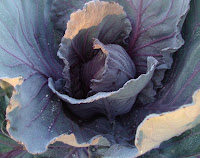 | |
| Ruby red cabbage |
 |
| Various tomatoes |
 |
| Caged cucumbers |
 | |
| Potatoes in bloom |
Three types of potatoes (kennebec, pontiac red, and yukon gold) are blooming so I'm looking forward to scrabbling along the edges for new potatoes in a week or two when the flowers die back. DH always acts irritated when I do that but the one year I managed to hold off, he came in carrying a bunch of golf ball-size potatoes in his shirttail asking if I would fix them for dinner.
Steamed, stir fried, pickled and straight from the vine -- that's how we've had sugar snap peas so far. I picked a couple of pounds right after taking this photo on Saturday and we should have another picking ready today or tomorrow. They will keep blooming if I keep them picked and the temperature doesn't soar again (and stay that way).
 |
| Blooming herbs and sugar snap vines loaded with peas |
Other than herbs, the other more-or-less permanent plantings like berries (blueberries, strawberries, raspberries and blackberries), rhubarb, garlic,etc. are not planted in the regular garden beds area. But a little over a year ago, my mother needed to relocate a gooseberry bush so DH said he'd just "heel it in" one of the garden beds. Well, after a brief discussion of where it should go "for good" -- I wanted to put it near the little one he constantly mows down in hopes he'd quit doing that, we promptly forgot about it and so it's stayed in it's temporary spot and, apparently, is thriving. DH took the headboard from an old maple bed frame I intended to use in a flower bed and set it as a support for the gooseberry. I guess I'll have to figure out how to prune this one but I kind of like the way it looks leaning on it's frame.
 |
| Watching the mist burn away as the day warms up - 6:30am on the first Saturday in June |
Monday, April 18, 2011
Busy, busy, busy -- must get back to a menu plan, week of 2011-04-18 plus Paneer Manchurian
Okay, so we're on this season's third (or is it the fourth?) complete new set of seedling flats under the lights. Lettuces, cabbages, broccoli, kale, spinach, lots of onions, some potatoes, horseradish, sugar snap peas, and some other cool weather veggies (daikon radishes? bok choy?) that I can't recall right now (nor ask DH because he's at work...) are growing out in the garden. The latest batch of seedlings, which DH spent part of the past weekend potting up in newspaper pots, is mainly tomatoes and peppers. We're getting ready for warm weather and the last average frost date for our area which is around May 15.
DS and I try to spend a couple hours every day weeding, trimming back herbs and mowing. Just yesterday I found, under the leaf mulch, two rhubarb starts that were planted late last year and I thought were lost to the fall's dry weather -- Cherry, I think, and Canada Red. Or maybe they're both Canada Red. I definitely need to keep better gardening notes...
And thinking of garden journaling, I should note that DH set out another grape vine last week, a seedless red called Reliance, plus, in an area of the backyard where plants often fail to thrive or even die because of the many black walnut trees, he put a couple of currant bushes. Currants, along with raspberries, are included on many plant lists suggested for tolerance to juglone. I'm determined to find productive plants that can co-exist, even thrive, with the black walnuts.
So whenever time is short (and, really, when isn't it?) I know I need to plan a menu in order to make the best use of available foods, leftovers, and prep time. Otherwise we end up stopping for a sub sandwich or chinese takeout when we'd be better off budgetwise and foodwise to eat at home or take a packed lunch with us. Not to mention it seems silly to spend so much time growing our own food only to declare we don't have time to prepare and eat it! So back to menu planning for me.
Monday, April 18
Potato soup with ham bits and fresh chives
Cornbread
Tuesday, April 19
Spaghetti with meat sauce
Carrots and celery sticks with ranch dressing as a dip
Wednesday, April 20
Egg salad or homemade pimiento cheese sandwiches
Harvey House slaw
Peach crisp
Thursday, April 21
Paneer Manchurian (recipe follows) over brown rice or noodles
Stir-fried vegetables (whatever's in the crisper or ready in the garden)
Stewed rhubarb
Friday, April 22
Scrambled eggs and/or sausage patties
Homemade biscuits and apple butter
Milk
Saturday, April 23
Country-style steak with gravy
Mashed potatoes
Green beans
Pickled beets
Sunday, April 24
Potato salad
Cold ham
Yeast rolls
Fruit salad
Oatmeal cookies or gingersnaps
_____________________________________________________
Paneer Manchurian
This is adapted from a recipe I found at dhara.org. The sauce is wonderful with the paneer but equally good on cubed and sauteed chicken or tofu, too.
12 to 16 ounces paneer, cubed
2 tablespoons grated ginger
1 tablespoon minced garlic
1 poblano pepper, diced or other fresh pepper of your choice
1 cup chopped onion
3 tablespoons soy sauce
1/4 cup ketchup
1 tablespoon sriracha sauce
up to 1/4 cup vegetable oil, divided
In a medium saucepan, heat a tablespoon of oil and add ginger, garlic, pepper and onion to saute. Stir in the soy sauce, ketchup and hot sauce after the onions have started to turn translucent and cook for a couple of minutes to blend flavors.
Meanwhile, heat a wok or iron skillet over high heat and add 2 tablespoons oil. Toss in half of the paneer and lightly brown on all sides, stirring or tossing as for stir-frying. Remove the toasted paneer to a holding dish or, if the sauce is finished, add to saucepan and toss lightly to coat. Add remaining 1 tablespoon of oil, if necessary, and repeat with the rest of the paneer. Serve with rice or noodles, if desired.
Notes: I use my home-canned Western Gourmet Ketchup but regular ketchup or even a thick tomato sauce (spicy or plain) would work, too.
I use a poblano pepper and opt for a hot sriracha sauce however it could be switched around a bit by choosing a hotter pepper but a milder sweet chile-garlic sauce instead of sriracha.
DS and I try to spend a couple hours every day weeding, trimming back herbs and mowing. Just yesterday I found, under the leaf mulch, two rhubarb starts that were planted late last year and I thought were lost to the fall's dry weather -- Cherry, I think, and Canada Red. Or maybe they're both Canada Red. I definitely need to keep better gardening notes...
And thinking of garden journaling, I should note that DH set out another grape vine last week, a seedless red called Reliance, plus, in an area of the backyard where plants often fail to thrive or even die because of the many black walnut trees, he put a couple of currant bushes. Currants, along with raspberries, are included on many plant lists suggested for tolerance to juglone. I'm determined to find productive plants that can co-exist, even thrive, with the black walnuts.
So whenever time is short (and, really, when isn't it?) I know I need to plan a menu in order to make the best use of available foods, leftovers, and prep time. Otherwise we end up stopping for a sub sandwich or chinese takeout when we'd be better off budgetwise and foodwise to eat at home or take a packed lunch with us. Not to mention it seems silly to spend so much time growing our own food only to declare we don't have time to prepare and eat it! So back to menu planning for me.
Monday, April 18
Potato soup with ham bits and fresh chives
Cornbread
Tuesday, April 19
Spaghetti with meat sauce
Carrots and celery sticks with ranch dressing as a dip
Wednesday, April 20
Egg salad or homemade pimiento cheese sandwiches
Harvey House slaw
Peach crisp
Thursday, April 21
Paneer Manchurian (recipe follows) over brown rice or noodles
Stir-fried vegetables (whatever's in the crisper or ready in the garden)
Stewed rhubarb
Friday, April 22
Scrambled eggs and/or sausage patties
Homemade biscuits and apple butter
Milk
Saturday, April 23
Country-style steak with gravy
Mashed potatoes
Green beans
Pickled beets
Sunday, April 24
Potato salad
Cold ham
Yeast rolls
Fruit salad
Oatmeal cookies or gingersnaps
_____________________________________________________
Paneer Manchurian
This is adapted from a recipe I found at dhara.org. The sauce is wonderful with the paneer but equally good on cubed and sauteed chicken or tofu, too.
12 to 16 ounces paneer, cubed
2 tablespoons grated ginger
1 tablespoon minced garlic
1 poblano pepper, diced or other fresh pepper of your choice
1 cup chopped onion
3 tablespoons soy sauce
1/4 cup ketchup
1 tablespoon sriracha sauce
up to 1/4 cup vegetable oil, divided
In a medium saucepan, heat a tablespoon of oil and add ginger, garlic, pepper and onion to saute. Stir in the soy sauce, ketchup and hot sauce after the onions have started to turn translucent and cook for a couple of minutes to blend flavors.
Meanwhile, heat a wok or iron skillet over high heat and add 2 tablespoons oil. Toss in half of the paneer and lightly brown on all sides, stirring or tossing as for stir-frying. Remove the toasted paneer to a holding dish or, if the sauce is finished, add to saucepan and toss lightly to coat. Add remaining 1 tablespoon of oil, if necessary, and repeat with the rest of the paneer. Serve with rice or noodles, if desired.
Notes: I use my home-canned Western Gourmet Ketchup but regular ketchup or even a thick tomato sauce (spicy or plain) would work, too.
I use a poblano pepper and opt for a hot sriracha sauce however it could be switched around a bit by choosing a hotter pepper but a milder sweet chile-garlic sauce instead of sriracha.
Thursday, March 17, 2011
Baby quilt with embroidery -- finished!
And before the baby's arrived, too. That's a new record.
I took the quilt block I embroidered last month and turned it into the center block for a 52"-square baby blanket. Backed with flannel and lined with a piece of white sheeting, it reminds me of two my grandmother made. They had tractors and farm animals and nursery rhyme scenes embroidered in the squares. And they wore out from my brother, my sister and I dragging them around wherever we went.
 My embroidery wasn't as ambitious. The fun duckling with balloons in the center block was a full design, the other four embroidered blocks were done to supplement and tie the overall design together. So I chose four simple shapes from Doodle Stitching: Fresh & Fun Embroidery for Beginners
My embroidery wasn't as ambitious. The fun duckling with balloons in the center block was a full design, the other four embroidered blocks were done to supplement and tie the overall design together. So I chose four simple shapes from Doodle Stitching: Fresh & Fun Embroidery for Beginners -- I found a dragonfly, butterfly and duckling that echoed the printed duck fabric's designs and then added a balloon for the fourth block, lifted from the larger duckling design in the center block.
-- I found a dragonfly, butterfly and duckling that echoed the printed duck fabric's designs and then added a balloon for the fourth block, lifted from the larger duckling design in the center block.
 When I drew out the quilt top on graph paper, I realized I didn't want to simply surround the center block with straight nine-patch blocks. That seemed sort of blah to me and, somehow, seemed to take away from my center block, too. So I used four nine-patch blocks with the plain, yet embroidered center squares and added those other four with the three long blocks of color in each. I know where that idea came from. Just prior to drawing out the overall design, I was reading a thread on Chickens in the Road and saw a photo of a just-completed baby quilt that I couldn't get out of my mind.
When I drew out the quilt top on graph paper, I realized I didn't want to simply surround the center block with straight nine-patch blocks. That seemed sort of blah to me and, somehow, seemed to take away from my center block, too. So I used four nine-patch blocks with the plain, yet embroidered center squares and added those other four with the three long blocks of color in each. I know where that idea came from. Just prior to drawing out the overall design, I was reading a thread on Chickens in the Road and saw a photo of a just-completed baby quilt that I couldn't get out of my mind.
This blanket is meant for regular use. To cover a sleeping baby, to spread on a floor to provide a toddler's play space or just to be dragged around by a growing child. It should go through the washer and dryer without a problem. And I hope it wears out just like the ones my grandmother made. I think that's what happens to all well-loved baby blankets and so it's what I wish for this one.
I took the quilt block I embroidered last month and turned it into the center block for a 52"-square baby blanket. Backed with flannel and lined with a piece of white sheeting, it reminds me of two my grandmother made. They had tractors and farm animals and nursery rhyme scenes embroidered in the squares. And they wore out from my brother, my sister and I dragging them around wherever we went.
 My embroidery wasn't as ambitious. The fun duckling with balloons in the center block was a full design, the other four embroidered blocks were done to supplement and tie the overall design together. So I chose four simple shapes from Doodle Stitching: Fresh & Fun Embroidery for Beginners
My embroidery wasn't as ambitious. The fun duckling with balloons in the center block was a full design, the other four embroidered blocks were done to supplement and tie the overall design together. So I chose four simple shapes from Doodle Stitching: Fresh & Fun Embroidery for Beginners When I drew out the quilt top on graph paper, I realized I didn't want to simply surround the center block with straight nine-patch blocks. That seemed sort of blah to me and, somehow, seemed to take away from my center block, too. So I used four nine-patch blocks with the plain, yet embroidered center squares and added those other four with the three long blocks of color in each. I know where that idea came from. Just prior to drawing out the overall design, I was reading a thread on Chickens in the Road and saw a photo of a just-completed baby quilt that I couldn't get out of my mind.
When I drew out the quilt top on graph paper, I realized I didn't want to simply surround the center block with straight nine-patch blocks. That seemed sort of blah to me and, somehow, seemed to take away from my center block, too. So I used four nine-patch blocks with the plain, yet embroidered center squares and added those other four with the three long blocks of color in each. I know where that idea came from. Just prior to drawing out the overall design, I was reading a thread on Chickens in the Road and saw a photo of a just-completed baby quilt that I couldn't get out of my mind.This blanket is meant for regular use. To cover a sleeping baby, to spread on a floor to provide a toddler's play space or just to be dragged around by a growing child. It should go through the washer and dryer without a problem. And I hope it wears out just like the ones my grandmother made. I think that's what happens to all well-loved baby blankets and so it's what I wish for this one.
Subscribe to:
Posts (Atom)




























